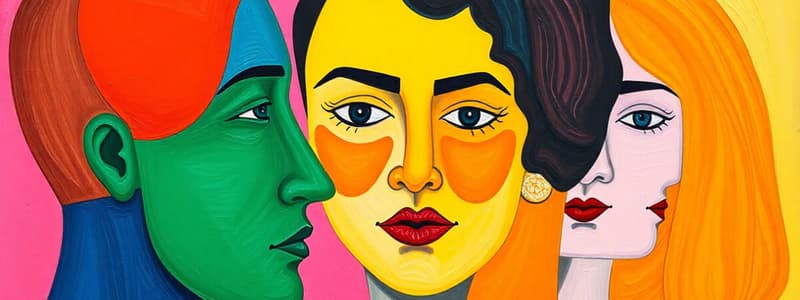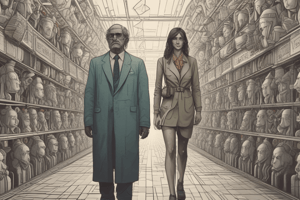Podcast
Questions and Answers
What are the three main components of stereotyping, prejudice, and discrimination?
What are the three main components of stereotyping, prejudice, and discrimination?
Stereotypes, prejudice, and discrimination.
Which of the following is NOT a component of stereotyping, prejudice, and discrimination?
Which of the following is NOT a component of stereotyping, prejudice, and discrimination?
- Bias (correct)
- Discrimination
- Stereotypes
- Prejudice
How does social categorization simplify information? What is a consequence of this simplification?
How does social categorization simplify information? What is a consequence of this simplification?
Social categorization simplifies information by grouping individuals into categories, leading to exaggerated intergroup differences and minimized intragroup differences.
The Minimal Group Paradigm suggests that even arbitrary group assignments can lead to bias.
The Minimal Group Paradigm suggests that even arbitrary group assignments can lead to bias.
Which type of bias is more obvious and intentional, often stemming from real or perceived conflicts?
Which type of bias is more obvious and intentional, often stemming from real or perceived conflicts?
Which theory suggests that group memberships contribute to an individual's self-esteem and influence their bias?
Which theory suggests that group memberships contribute to an individual's self-esteem and influence their bias?
The Self-Categorization Theory suggests that an individual's identity remains consistent regardless of their social context.
The Self-Categorization Theory suggests that an individual's identity remains consistent regardless of their social context.
Stereotypes are always activated automatically, regardless of the situation or cognitive load.
Stereotypes are always activated automatically, regardless of the situation or cognitive load.
What are two strategies that can be employed to reduce reliance on stereotypes?
What are two strategies that can be employed to reduce reliance on stereotypes?
What is the term for the doubt experienced by targets of stereotypes when receiving feedback, leading them to question if it is genuinely deserved?
What is the term for the doubt experienced by targets of stereotypes when receiving feedback, leading them to question if it is genuinely deserved?
What is 'Stereotype Threat,' and what impact can it have?
What is 'Stereotype Threat,' and what impact can it have?
While stereotypes are cognitive in nature, emotions play a minor role in prejudice.
While stereotypes are cognitive in nature, emotions play a minor role in prejudice.
Describe the two dimensions used in the Stereotype Content Model (SCM).
Describe the two dimensions used in the Stereotype Content Model (SCM).
Match the following SCM combinations with the associated emotional prejudice:
Match the following SCM combinations with the associated emotional prejudice:
What are the two types of threats encompassed by the Integrated Threat Theory?
What are the two types of threats encompassed by the Integrated Threat Theory?
According to research, race-based prejudice is primarily rooted in biological differences rather than social constructs.
According to research, race-based prejudice is primarily rooted in biological differences rather than social constructs.
Briefly explain the concept of ambivalent sexism.
Briefly explain the concept of ambivalent sexism.
Ageism is primarily concerned with the physical characteristics of older individuals.
Ageism is primarily concerned with the physical characteristics of older individuals.
What is a common characteristic of sexual prejudice, often driving discrimination based on nonvisible identities?
What is a common characteristic of sexual prejudice, often driving discrimination based on nonvisible identities?
What is the key principle behind the Contact Hypothesis, and what conditions must be met for it to effectively reduce prejudice?
What is the key principle behind the Contact Hypothesis, and what conditions must be met for it to effectively reduce prejudice?
Empathy and perspective-taking can be detrimental to intergroup relations by exacerbating negativity and prejudice.
Empathy and perspective-taking can be detrimental to intergroup relations by exacerbating negativity and prejudice.
Flashcards
Stereotypes
Stereotypes
Simplified mental representations of a group, often based on common characteristics. They can be positive, negative, or neutral.
Prejudice
Prejudice
Emotional attitude towards a group based on stereotypes, often involving negative feelings like dislike, distrust, or anger.
Discrimination
Discrimination
Actions taken based on prejudice, often causing harm or unfair treatment to members of a group.
Social Categorization
Social Categorization
Signup and view all the flashcards
Blatant Bias
Blatant Bias
Signup and view all the flashcards
Subtle Bias
Subtle Bias
Signup and view all the flashcards
Social Identity Theory
Social Identity Theory
Signup and view all the flashcards
Self-Categorization Theory
Self-Categorization Theory
Signup and view all the flashcards
Stereotype Activation
Stereotype Activation
Signup and view all the flashcards
Motivated Control
Motivated Control
Signup and view all the flashcards
Attributional Ambiguity
Attributional Ambiguity
Signup and view all the flashcards
Stereotype Threat
Stereotype Threat
Signup and view all the flashcards
Emotional Prejudice
Emotional Prejudice
Signup and view all the flashcards
Stereotype Content Model (SCM)
Stereotype Content Model (SCM)
Signup and view all the flashcards
SCM - Emotional Reactions
SCM - Emotional Reactions
Signup and view all the flashcards
BIAS Map
BIAS Map
Signup and view all the flashcards
Integrated Threat Theory
Integrated Threat Theory
Signup and view all the flashcards
Racial Prejudice
Racial Prejudice
Signup and view all the flashcards
Ambivalent Sexism
Ambivalent Sexism
Signup and view all the flashcards
Ageism
Ageism
Signup and view all the flashcards
Sexual Prejudice
Sexual Prejudice
Signup and view all the flashcards
Contact Hypothesis
Contact Hypothesis
Signup and view all the flashcards
Conditions for Contact Hypothesis
Conditions for Contact Hypothesis
Signup and view all the flashcards
Empathy and Perspective-Taking
Empathy and Perspective-Taking
Signup and view all the flashcards
Warmth and Competence
Warmth and Competence
Signup and view all the flashcards
Emotional Reactions - SCM
Emotional Reactions - SCM
Signup and view all the flashcards
BIAS Map - Actions and Attention
BIAS Map - Actions and Attention
Signup and view all the flashcards
Integrated Threat Theory - Prejudice
Integrated Threat Theory - Prejudice
Signup and view all the flashcards
Racial Prejudice
Racial Prejudice
Signup and view all the flashcards
Ambivalent Sexism
Ambivalent Sexism
Signup and view all the flashcards
Ageism
Ageism
Signup and view all the flashcards
Sexual Prejudice
Sexual Prejudice
Signup and view all the flashcards
Study Notes
Stereotyping, Prejudice, and Bias
- Stereotypes are cognitive structures containing beliefs about a group.
- Prejudice is an emotional evaluation of a group.
- Discrimination refers to behaviors driven by prejudice.
- Categorization simplifies information but leads to exaggerated intergroup differences and minimized intragroup differences.
- Blatant bias involves overt favoritism or derogation.
- Subtle bias is more latent, automatic, and unconscious, stemming from cognitive processes.
- Social Identity Theory posits that group memberships contribute to self-esteem.
- Self-Categorization Theory suggests identity shifts depending on social context.
- Stereotypes are not always automatically activated; their application depends on context and cognitive load.
- Stereotypes can be weakened through perspective-taking, training, and intentional counter-stereotypical thinking.
- Attributional Ambiguity: Targets of stereotypes question whether feedback is biased.
- Stereotype Threat: Fear of confirming stereotypes can reduce performance.
Prejudice and Its Emotional Dimensions
- Though stereotypes are cognitive, emotional prejudices often drive discrimination more directly.
- Stereotype Content Model (SCM) evaluates groups along warmth and competence dimensions.
- High warmth, low competence (e.g., elderly): Pity.
- High warmth, high competence (e.g., allies): Admiration.
- Low warmth, low competence (e.g., outgroups): Contempt.
- Low warmth, high competence (e.g., rivals): Envy.
Behavioral Implications (BIAS Map)
- Warmth predicts active behaviors, while competence predicts passive behaviors.
- Realistic and symbolic threats shape prejudice.
- Group-specific prejudices are rooted in social constructs, not biology.
- Examples include: race, gender, ageism and sexual prejudice
- Positive intergroup contact reduces prejudice if conditions like equal status and shared goals are met.
- Empathy and perspective-taking reduce negative stereotypes.
Studying That Suits You
Use AI to generate personalized quizzes and flashcards to suit your learning preferences.



